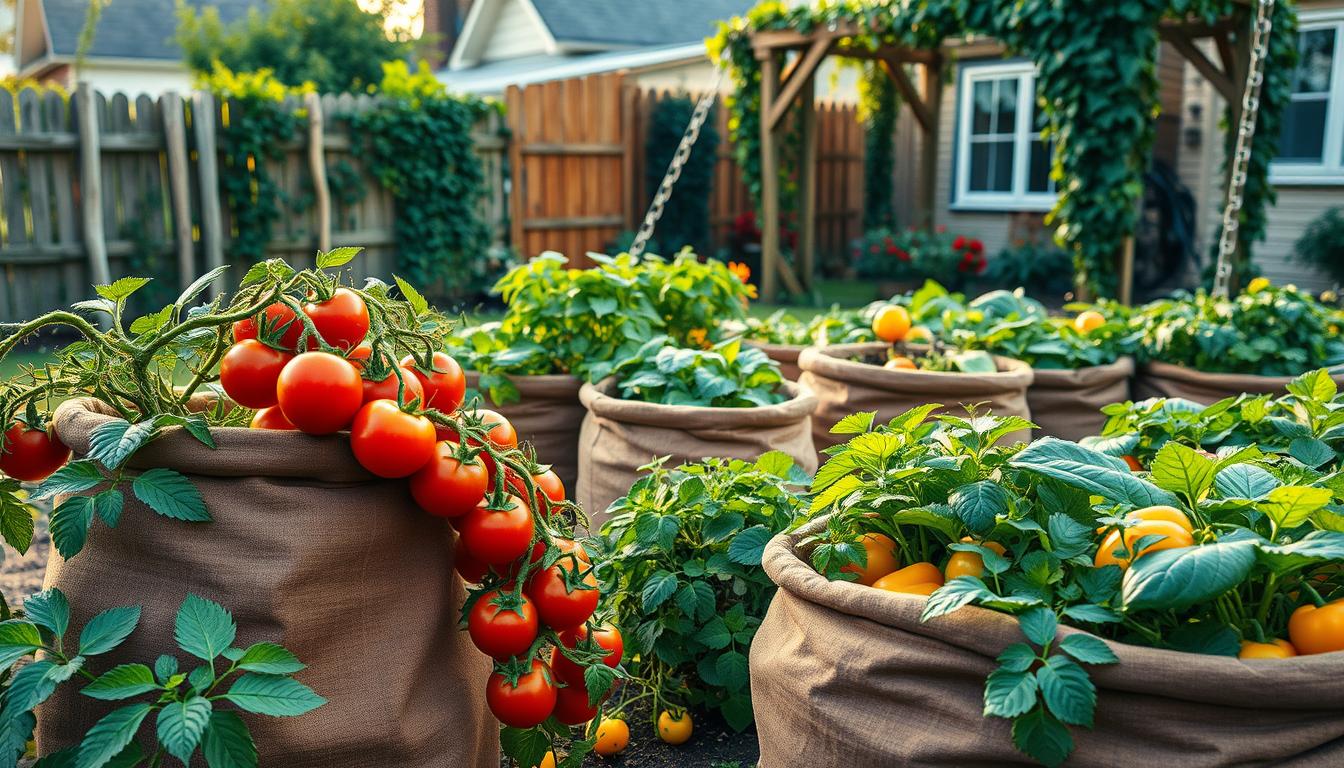Imagine picking fresh tomatoes from your balcony or crisp lettuce from your yard, even with bad soil. This isn’t just a dream—it’s real for many gardeners. They’ve found the secret in fabric planters.
Fabric containers have changed gardening. They’re better than old pots or digging in the ground. They let roots breathe, stop circling, and fit anywhere with sun.
They’re great for beginners or experienced gardeners. Vegetable grow bags are easy to use, cheap, and last a long time. They’re loved by many for good reasons.
The Rise of Container Gardening in Modern Spaces
Container gardening has changed urban areas into places where people can grow their own food. It started as a way for apartment dwellers to garden. Now, it’s a big movement that changes how we grow food.
City dwellers face challenges when growing their own food. They have to use balconies, patios, rooftops, and windowsills. Yet, they still want to grow their own food and connect with nature.
Container gardening bags are perfect for city living. They mix the best of traditional gardening with the needs of urban life. As more people garden in containers, there are more products made just for them.
Urban Gardening Challenges and Solutions
Urban gardeners face unique problems. They deal with concrete, small spaces, poor soil, and less sunlight. They also face rules from landlords that don’t allow permanent gardens.
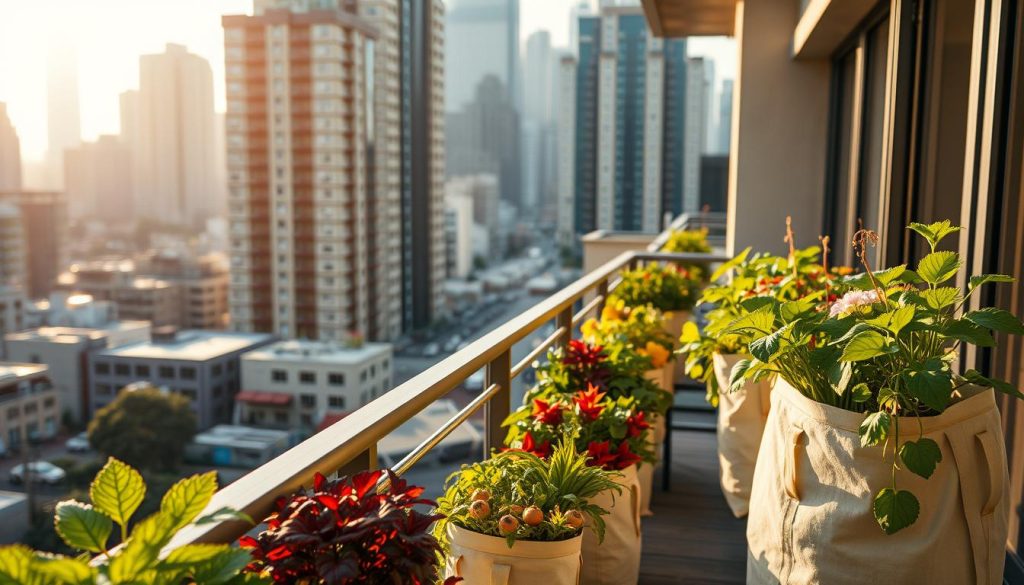
Container gardening solves these problems. Garden bags can be moved and placed where it’s sunny. They also use fresh soil, not contaminated city soil.
These bags are great for renters because they can take them when they move. This flexibility is key for many city gardeners. It lets them grow food even when they move.
The Evolution from Traditional Pots to Innovative Containers
Container gardening has changed a lot. It started with clay pots, but they were heavy and broke easily. Then, plastic pots came, but they weren’t durable or good for the environment.
Fabric grow bags changed everything. They are light, breathe well, and don’t break. They also help plants grow better by preventing root circling.
Now, there are many types of container gardening bags. Some have water reservoirs for busy people. Others are easy to carry. There are even biodegradable and collapsible options.
This change shows a shift towards practical and green gardening. Container gardening bags make it easy for people to grow food, even in small spaces. They’re not just for gardening; they’re a way to be self-sufficient in the city.
Understanding Grow Bags for Vegetables: The Basics
The humble grow bag is more than meets the eye. It’s a blend of plant science and design that traditional containers can’t match. As gardeners discover their benefits, grow bags have become a key tool in gardening. They offer the right mix of drainage, aeration, and root growth for vegetables.
Grow bags create a special environment for plants. Their design solves common problems in container gardening. They’re a game-changer for growing vegetables and should be in every gardener’s toolkit.
What Makes Fabric Grow Bags Different
Fabric pots for plants are different from traditional containers. They’re made from breathable fabrics like non-woven polypropylene or natural materials. This makes them special.
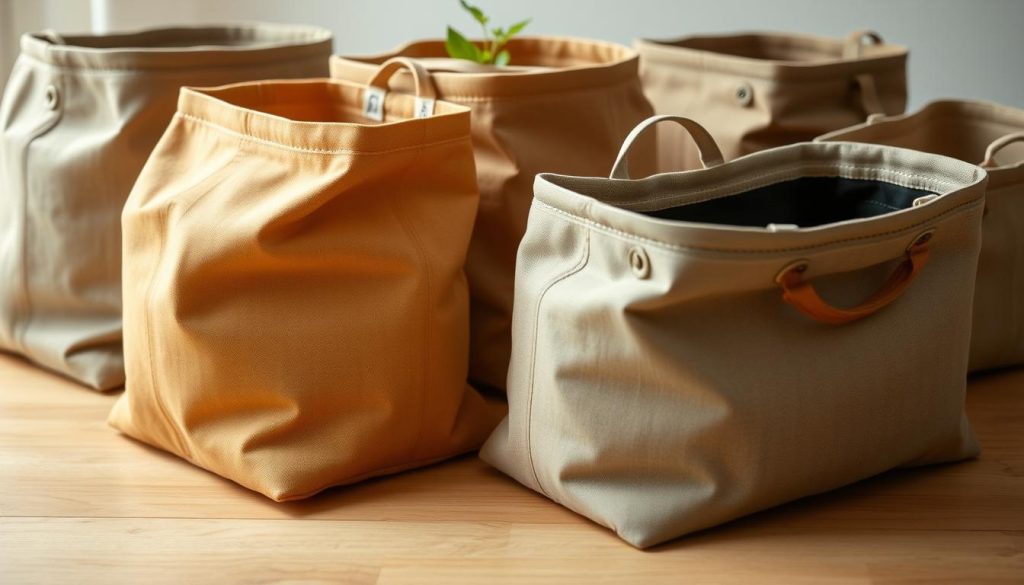
- Enhanced oxygen exchange throughout the entire root zone
- Superior drainage that prevents waterlogging and root rot
- Ability to “breathe” excess heat away from the root system
- Lightweight design that allows for easy repositioning
- Collapsible structure for simple storage during off-seasons
When you water a fabric grow bag, excess moisture evaporates. This prevents waterlogging and root rot. The fabric also stops roots from circling, a common problem in plastic pots.
The Science of Air Pruning and Root Health
Fabric grow bags revolutionize root growth through air pruning. This natural process improves root structure and plant health. It changes how roots develop and function.
In traditional containers, roots circle around the container wall. This creates a tangled root system. Fabric grow bags prevent this through air pruning.
How Air Pruning Creates Stronger Plants
When roots reach the edge of a fabric grow bag, they encounter air. This “prunes” the root tip, stopping its growth. The plant then develops more lateral roots and fine root hairs.
This branching leads to a denser, more efficient root system. Plants with air-pruned roots grow stronger, resist drought better, and absorb nutrients more efficiently. This results in healthier growth and better harvests.
Temperature Regulation Benefits
Fabric grow bags regulate soil temperature well. In summer, they let excess heat escape, keeping roots cooler. This is better than plastic or ceramic containers that trap heat.
This cooling effect is great for heat-sensitive vegetables. In cooler seasons, fabric pots warm up faster. Dark-colored fabric pots can even keep soil warmer in spring and fall, extending growing seasons.
7 Game-Changing Benefits of Vegetable Grow Bags
Fabric grow bags bring seven key benefits to growing veggies. They’ve changed my gardening game. These bags are perfect for small spaces, offering advantages over regular pots.
Portability and Versatility for Any Space
Grow bags are light and easy to move. You can follow the sun or move them to avoid bad weather. They’re great for balconies, patios, and more.
They’re also easy to store. Just empty, fold, and put them away when it’s cold. This saves space and keeps them ready for next year.
Grow bags are affordable. They cost less than other containers but perform better. This makes them a smart choice for any gardener.
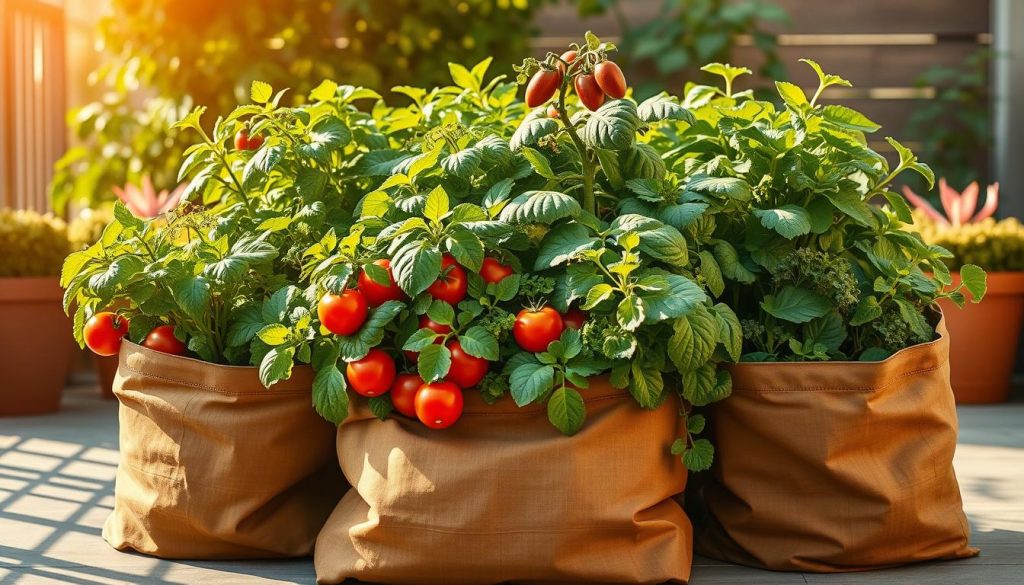
Superior Drainage and Aeration
Fabric grow bags breathe well. This stops root rot by letting water drain. It’s a big plus over plastic containers.
The fabric also helps roots grow better. Air pruning encourages roots to branch out. This leads to healthier plants that grow stronger.
Soil in grow bags warms up faster. This means you can plant earlier. It’s a great way to get a head start on the growing season.
Extended Growing Seasons
Grow bags let you grow longer. They warm up faster than soil in spring. This means you can start plants like tomatoes and peppers sooner.
In fall, move bags to safe spots or indoors. This adds weeks or months to your growing season. It’s perfect for plants that don’t like cold.
These bags are also good for the planet. They last 3-5 seasons with care. This makes them a better choice than plastic containers.
Reduced Pest and Disease Problems
Grow bags help avoid pests and diseases. The drainage stops waterlogged soil. This keeps away slugs and some fungi.
If problems do show up, you can move the bag. This stops the issue from spreading. It’s a simple way to manage pests.
Starting fresh with new soil each season helps too. This breaks pest cycles. It means fewer chemicals and healthier plants over time.
Selecting the Perfect Grow Bags for Your Garden
Choosing the right grow bags for your garden is key. Not all bags are the same. It’s important to know what to look for.
With so many options, it can be hard to pick the best. Let’s look at what matters most for your garden’s success.
Material Matters: Fabric, Plastic, and Biodegradable Options
The material of your grow bags affects your plants and the environment. Each type has its own benefits and drawbacks.
Fabric bags are popular among gardeners. They let air in and prevent roots from circling. They’re also UV-resistant and can last 3-5 seasons.
Plastic bags hold water well but don’t breathe as much. They’re cheaper and can last 1-3 seasons. Make sure they’re BPA-free if you’re growing food.
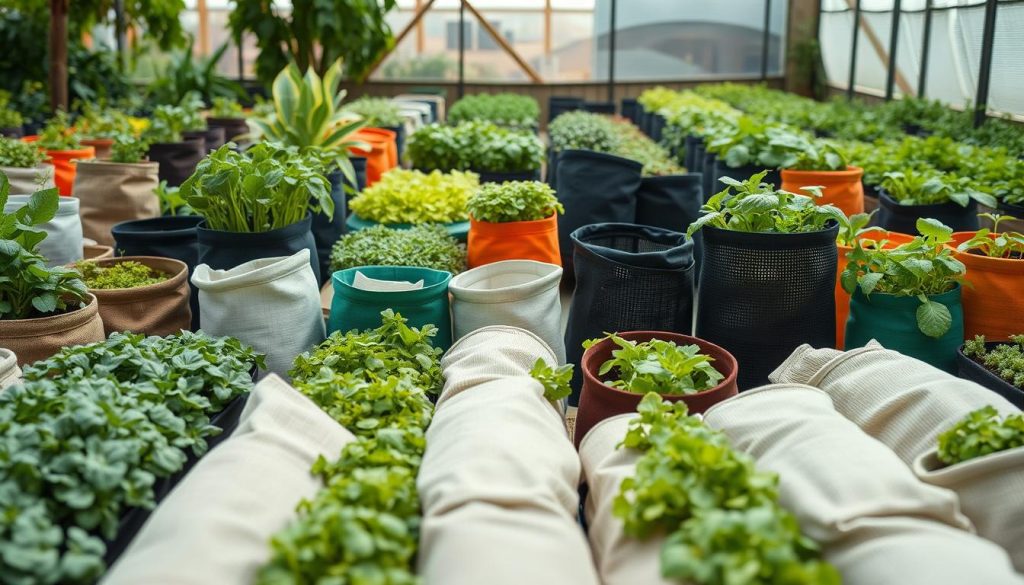
Biodegradable bags are good for the planet. They’re made from materials like coconut coir and break down in 1-2 seasons. They’re more expensive but great for eco-friendly gardeners.
Size and Depth Guidelines for Different Vegetables
Choosing the right size bag is crucial. Small bags can stunt plant growth. This leads to poor harvests.
The size you need depends on what you’re growing. Here’s a guide to help you choose:
| Vegetable Type | Minimum Bag Size | Ideal Depth | Plants Per Bag |
|---|---|---|---|
| Leafy Greens (Lettuce, Spinach) | 3-5 gallons | 8-10 inches | 3-4 plants |
| Root Vegetables (Carrots, Radishes) | 5-7 gallons | 12-14 inches | 8-10 plants |
| Peppers & Eggplants | 5 gallons | 10-12 inches | 1 plant |
| Tomatoes & Potatoes | 10-15 gallons | 14-18 inches | 1 plant |
| Squash & Cucumbers | 7-10 gallons | 12-14 inches | 1-2 plants |
Quality Features Worth the Investment
When buying grow bags, look for quality features. These can make a big difference in how long your bags last.
Stitching and Reinforcement Indicators
Check the stitching before you buy. Double stitching means the bag is well-made and won’t split. Look for reinforced stress points, like where handles meet the bag.
Some bags have bound edges to prevent fraying. This helps them last longer.
Handle Designs and Durability
Handles are important for moving bags. They should be wide and securely attached. Some bags have wrap-around handles that support the bag’s weight.
The best bags are well-designed and made with quality materials. They’ll serve your garden for many seasons. By choosing the right bags, you’ll have a productive and practical garden.
Creating Your Grow Bag Garden: Step-by-Step Setup
Turning your patio or balcony into a garden is exciting. Start by setting up your grow bags right. Garden grow bags are flexible, but a good setup is key to success. Follow these steps to make a container garden that will give you lots of harvests.
Finding the Optimal Location for Maximum Yields
The right spot for your grow bags is crucial. Most veggies need 6-8 hours of sunlight a day. South-facing spots get the most light in the Northern Hemisphere.
Think about these things when picking a spot:
- Sunlight patterns throughout the day and seasons
- Protection from strong winds that can dry out containers quickly
- Easy access for daily care and harvesting
- Proximity to a water source to simplify irrigation
- Weight considerations for balconies and elevated structures
Don’t forget about looks! Arrange your grow bags to make your outdoor space beautiful. Grouping similar plants or creating tiered displays can make your garden a stunning feature.
Crafting the Ideal Soil Mix for Container Success
Don’t use regular garden soil in grow bags. It gets too dense and blocks roots. Instead, make a mix that’s light, rich in nutrients, and made for containers.
- 40% high-quality compost for nutrients and beneficial microbes
- 30% coconut coir or peat moss for water retention
- 20% perlite or vermiculite for drainage and aeration
- 10% worm castings for slow-release nutrients
For heavy feeders like tomatoes and peppers, add a balanced organic fertilizer before planting. This mix balances moisture and drainage, helping your plants grow well.
Watering Systems and Moisture Management
Watering your grow bags right is key. The fabric drains well but means you’ll need to water more often. On hot days, you might need to water daily or twice for thirsty plants.
Use the finger test to check when to water. Stick your finger an inch into the soil. If it’s dry, it’s time to water. Water well until you see moisture at the bottom of the bag. This helps roots grow deep.
Drip Irrigation Options
Setting up a drip irrigation system saves time and boosts your garden’s health. It delivers water directly to the soil, cutting down on evaporation and keeping leaves dry. This helps prevent diseases.
Here are some good options:
- Micro-drip kits with adjustable emitters for each bag
- Soaker hoses weaved among multiple grow bags
- Timer-controlled systems for consistent watering when you’re busy or away
For small gardens, a simple gravity-fed system works great. It takes some effort to set up, but it’s worth it for better plant health.
Self-Watering Techniques
Self-watering systems make caring for your grow bags easier, even if you’re busy. They work by creating a water reservoir that plants can draw from as needed.
You can make your own self-watering grow bags by:
- Placing a perforated plastic bottle in the center of your soil mix
- Using wicking systems with cotton ropes that draw water from a reservoir below
- Adding water-absorbing crystals to your soil mix to extend time between waterings
Commercial options include grow bags with built-in reservoirs or outer slings that hold water. These systems cut down on daily care while keeping plants moist. For gardeners with little time, this is a smart investment.
Top 10 Vegetables That Excel in Grow Bags
Many vegetables grow well in containers, but some excel in fabric grow bags. These bags offer great drainage, aeration, and temperature control. They’re perfect for small spaces or boosting garden productivity.
Shallow-Rooted Stars: Lettuce, Herbs, and Greens
Leafy greens and herbs love shallow grow bags, needing only 6-8 inches of soil. Lettuce types like ‘Buttercrunch’ and ‘Red Sails’ grow well, allowing for multiple harvests.
Culinary herbs like basil, cilantro, parsley, and thyme make a great kitchen garden in one bag. Mixing herbs in one bag looks beautiful and saves space. Try planting spinach, arugula, and Asian greens like bok choy for continuous harvests.
These plants grow fast, so you can harvest and replant many times in a season. I love making a salad mix grow bag. It gives you fresh salads for weeks from just one planting.
Medium-Depth Champions: Peppers, Eggplants, and Beans
Medium-sized grow bags (10-15 gallons) are ideal for crops with moderate roots. Bell peppers and hot peppers love the warm soil of fabric grow bags. Compact varieties like ‘Redskin’ bell peppers and ‘Thai Hot’ chilies yield well in small spaces.
Eggplants, which love heat, do great in dark-colored grow bags. These bags absorb sunlight and warm the soil. ‘Fairy Tale’ and ‘Patio Baby’ eggplants are bred for containers, producing tender fruits.
Bush beans like ‘Provider’ and ‘Derby’ grow well in grow bags. Dwarf peas like ‘Tom Thumb’ can be grown along the edges with supports. For summer squash, try compact zucchini varieties like ‘Eight Ball’ and ‘Patio Star’.
Deep-Rooted Powerhouses: Tomatoes, Potatoes, and Root Crops
The biggest grow bags (20+ gallons) are for vegetables with big roots. Determinate tomatoes like ‘Roma’ and ‘Patio Princess’ are compact and yield well. Indeterminate varieties like ‘Sungold’ and ‘Brandywine’ can be trained up supports for months of production.
Potatoes do great in deep grow bags, allowing for the “hilling” technique. This method can yield over 5 pounds of potatoes from a 15-gallon bag. Try ‘Yukon Gold’ and ‘Red Pontiac’ varieties.
Root vegetables need depth but give big harvests. Carrots, beets, and radishes grow well in deep soil. The soil in fabric grow bags prevents root problems seen in heavy soils.
For the best production, try companion planting in large bags. I’ve grown determinate tomatoes with basil and marigolds in a 25-gallon bag. This combo is productive and pest-resistant, making the most of your space and enhancing flavors.
Overcoming Common Challenges with Grow Bags
Fabric pots for plants have their own set of challenges. But, these issues can be solved with the right knowledge and techniques. As someone who uses grow bags, I’ve learned how to overcome these problems. This way, you can avoid the learning curve.
Knowing these common challenges helps you prepare and respond effectively. This ensures your container garden thrives, no matter what. Let’s look at the most frequent grow bag obstacles and their solutions.
Mastering Watering Frequency and Techniques
Water management is a big challenge with container gardening bags. They dry out faster because of their porous nature and increased aeration. This is both a blessing and a challenge.
The finger test is your most reliable tool for checking soil moisture. Stick your finger about an inch into the soil. If it’s dry, it’s time to water. In summer, you might need to water every day. Spring and fall might require 2-3 waterings a week.
| Plant Type | Grow Bag Size | Weather Condition | Watering Frequency | Watering Technique |
|---|---|---|---|---|
| Leafy Greens | 3-5 gallons | Mild (65-75°F) | Every 2-3 days | Light, even watering |
| Tomatoes | 10+ gallons | Hot (85°F+) | Daily | Deep watering at base |
| Root Vegetables | 7-10 gallons | Moderate (75-85°F) | Every 2 days | Consistent moisture |
| Herbs | 1-3 gallons | Indoor/Mild | When top inch is dry | Light misting |
Self-watering systems like drip irrigation or wicking setups can be a big help. They’re great if you’re away from home a lot. For bigger gardens, consider a simple timer-based drip system. It delivers moisture directly to the roots.
Protecting Plants from Weather Extremes
Weather extremes can be tough on fabric pots for plants. But, their portability is a big advantage. You can move them to safer spots when needed.
In heatwaves, move sensitive plants to shaded areas. If you can’t move them, use umbrellas or shade cloth for temporary shade. Clustering bags together helps maintain humidity.
For cold snaps, bring small bags indoors at night. For bigger containers, wrap the sides with bubble wrap or blankets. This keeps the roots warm without harming the top growth.
Heavy rain can also be a problem. It can make the soil in container bags waterlogged. To prevent this, elevate your bags on bricks or stands. This improves drainage and prevents root diseases.
Extending Your Grow Bags’ Lifespan
Quality fabric grow bags can last 3-5 seasons with proper care. They’re a great investment. The key is to address wear and tear quickly and store them right between seasons.
Cleaning and Storage Best Practices
Cleaning your bags at the end of the season prevents disease and extends their life. Start by emptying the soil. Save it for next season by adding compost.
Brush off dried soil and rinse the bags gently with a hose. Avoid high-pressure washing, which can damage the fabric. For stains or mildew, soak the bags in a vinegar solution for an hour. Rinse well and let them dry in the sun.
Store clean, dry bags flat or loosely folded in a rodent-proof container. Don’t cram them too tightly, as this can cause permanent damage. Keep them in a cool, dry place to prevent mildew during the off-season.
Repair Techniques for Damaged Bags
Small tears and split seams are common but can be fixed easily. For tears under 2 inches, use a heavy-duty needle and UV-resistant thread. Stitch the opening closed with a simple whip stitch. Larger tears may need a fabric patch applied with waterproof glue.
Failed handles can be strengthened by sewing on strips of durable webbing or repurposed canvas. This often makes the handles stronger than before. For bags with degraded bottom drainage, use a heated screwdriver tip to create new holes without fraying.
By following these simple maintenance practices, you can extend your grow bags’ life. Remember, some wear is normal and doesn’t affect their function. Embrace the weathered look as a sign of your gardening experience!
Grow Bags vs. Traditional Gardening: An Honest Comparison
Urban gardening is changing, and it’s important to know how grow bags compare to traditional gardening. Both have their own benefits, and many gardeners mix both methods. Let’s look at the main differences to help you choose what works best for you.
Initial Investment vs. Long-Term Value
Traditional gardening might seem cheaper at first. You need lumber, soil, and tools for a basic raised bed. But, it’s not always the best choice when space is tight or the soil is poor.
Grow bags cost $15-30 each, depending on size and material. They might seem pricey at first, but they offer long-term benefits. You can move them easily, which is hard with permanent beds.
Grow bags also save you money on frames. They can last 3-5 seasons with care, making them cost-effective. Plus, you can fold and store them during off-seasons, extending their life.
Productivity and Harvest Differences
Traditional beds offer more soil for deep-rooted plants like tomatoes. They also keep moisture and temperature stable, helping plants grow better.
Grow bags, on the other hand, warm the soil faster, allowing for earlier planting. Their drainage and aeration help plants grow stronger, thanks to air pruning. This is great for plants that don’t like too much water.
In my experience, leafy greens, peppers, and herbs do well in grow bags. Root crops and sprawling plants like squash do better in ground gardens. Grow bags let you tailor the soil for each crop.
Time and Effort Requirements
Traditional gardening takes a lot of work at the start. Digging, building beds, and amending soil can take days. But, once set up, they need less watering because they tap into subsoil moisture.
Grow bags are easy to set up. You can start a garden in hours, not days. They need more watering because the fabric lets water evaporate faster.
Grow bags make cleanup easy. You can empty them, compost the soil, and store them for next season. This is much simpler than traditional beds.
Many gardeners use both methods. They have permanent beds for perennials and grow bags for mobile or special soil needs. This mix of methods is often the most effective.
Why I’ll Never Go Back to Traditional Garden Beds
Five years ago, I was a skeptic. Growing tomatoes in fabric bags seemed like a passing trend. Now, my collection of portable garden bags has changed my gardening game.
What convinced me? It was solving real problems. My clay soil made root vegetables stunted. But, my first crop of carrots in grow bags was straight and perfect.
During a three-week rainy spell, my pepper plants in reusable bags thrived. They had perfect drainage, unlike my flooded in-ground beds.
The freedom to move plants has been a game-changer. When my neighbor’s fence cast shade on my cucumbers, I moved the bags to a sunnier spot. Traditional garden beds can’t be moved like that!
I’ve found new joys too. Rearranging my garden keeps it fresh. Growing potatoes in bags means no back-breaking digging at harvest time. And, I can garden on my rental property’s concrete patio, taking my garden with me when I move.
Are grow bags perfect? No gardening method is. They need more frequent watering in hot weather. But, the benefits are worth it for me.
I still have a small raised bed for perennial herbs. But, 80% of my vegetables grow in fabric bags. If you’re curious, start small. Try a few portable garden bags alongside your traditional methods this season. Like me, you might find yourself gradually converting more of your garden to these versatile containers each year.

